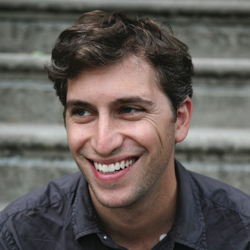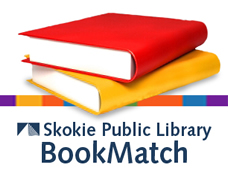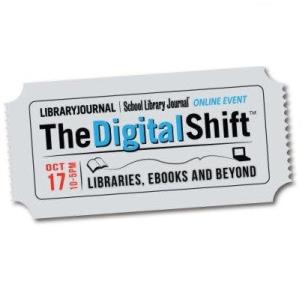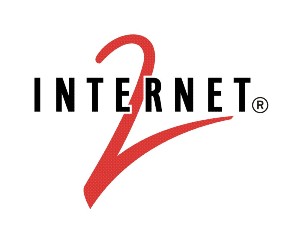
Andrew Blum
Andrew Blum, author of Tubes: A Journey to the Center of the Internet, kicked off LJ’s The Digital Shift: Libraries, Ebooks, and Beyond online event with an eye-opening keynote about the little-known physical infrastructure which underlies the Web. From seeing a cross-Atlantic cable pulled up onto the beach in Lisbon by a guy in a wetsuit, to touring the Facebook data center in middle America, to the little known Internet “capital” Ashford, VA, where “distribution depots” cluster, to the squirrel that chewed up his own connection, Blum gave the sometimes abstract subject matter a literal grounding in the basics.
(The squirrel would come back to haunt the event later, when fellow keynoter Cory Doctorow’s connection failed, forcing LJ’s Josh Hadro to conduct what one Twitter commenter called a “séance”, relaying audience questions to Doctorow and his replies back to the audience.)
Discovering Ebooks
In the “ABCs of eBook Discovery,” Head of Readers’ Advisory for the Darien Public Library Stephanie Anderson sounded a note that would resound throughout the discussion when she said that these days, ebook discovery is more about patrons discovering the fact that their library HAS ebooks, and how to borrow and read them, than it is about discovering particular titles, and “does that count?”
“It is currently so complicated” to check out an ebook, she said, that by the time she’s explained how to do it, “there’s not much time left to talk about what to read.”
Among the most effective methods in use at Darien are the simple and old-fashioned talking to people—both in the library and in outreach at places like Darien’s heavily trafficked commuter rail station—and putting out printed how-to handouts for patrons to take home. Since among Darien’s largest ebook demographics are senior citizens and moms with kids, being able to take the instructions home is a big help, according to Anderson.
For particular title discovery, a 3M cloud kiosk helps, but most people are finding their books at home via the catalog. Unfortunately, Anderson doesn’t yet have the capacity to customize that catalog to include the kind of reader’s advisory information librarians would provide in person, such as what books are popular, or which ones are being read by local book groups or library staff.
 Toby Greenwalt, Virtual Services Coordinator at Skokie Public Library, answered “does it count” with a resounding yes, saying “discovery has to diversify” into many things beyond titles. He also noted Skokie’s many related programs, including: its ereader test drive program, which lets patrons try out various devices; curated, pre-loaded ereaders which are checked out; “Bookmatch” guided reader survey; “FastMatch” based on library staff’s book reviews (Greenwalt likewise made mention of a shared repository where code for these tools would be provided). Skokie staff will also make readalike recommendations on social media but, said Greenwalt, it is “a lot trickier when it comes to ebooks” because they have to filter their suggestions through what’s available in the various formats.
Toby Greenwalt, Virtual Services Coordinator at Skokie Public Library, answered “does it count” with a resounding yes, saying “discovery has to diversify” into many things beyond titles. He also noted Skokie’s many related programs, including: its ereader test drive program, which lets patrons try out various devices; curated, pre-loaded ereaders which are checked out; “Bookmatch” guided reader survey; “FastMatch” based on library staff’s book reviews (Greenwalt likewise made mention of a shared repository where code for these tools would be provided). Skokie staff will also make readalike recommendations on social media but, said Greenwalt, it is “a lot trickier when it comes to ebooks” because they have to filter their suggestions through what’s available in the various formats.
Sarah Houghton, Director of San Rafael Public Library, concurred that discovery via the catalog is a problem, and adds that this takes on additional dimensions when it comes to free ebook resources, such as those available from Project Gutenberg, and when the catalog is shared with other members of a consortium. Houghton also said that the ebook title discovery process is constrained by not directing patrons to bestsellers, where waiting periods will give them a negative experience, and by situations where due to changing availability, the library owns the earlier volumes of a series in ebook form, but not the most recent.
Houghton also sounded a forceful call for librarians take a stand against ebooks locked up in restrictive DRM or licensed under unfavorable terms, saying that if these issues aren’t fixed by the time a contract is up, her library will simply refuse to renew. San Rafael is also shipping all its discards to The Internet Archive’s Open Library to grow its free ebook collection.
Collection Development in the Ebook Era
In “Integrating and Balancing E & P: Big Picture Issues Made Real,” moderator Michael Santangelo, Electronic Resources Analyst in the Collection Development Department at the Brooklyn Public Library led panelists through a discussion covering several challenges that libraries face as demand for ebooks continues growing, even as collection budgets get cut or remain flat.
Panelist Noel Rutherford, Manager of Collection Development and Acquisitions at the Nashville Public Library said that she has shifted 12 to 15 percent of NPL’s acquisitions budget to ebooks as demand for the format picks up. Eventually, she expects the library to spend less, but she said that it’s important to build up an ebook library quickly in order to earn patrons’ interest while they are still learning about the format.
To find the funds, librarians often need to find places to cut.
“There’s been so much die off in reference and periodicals and databases, it hasn’t been hard to take that money and put it into ebooks,” she said.
 San Diego County Library, the 2012 Gale/Library Journal Library of the Year has just begun building its ebook selection as it begins to emerge from a very difficult budgetary period.
San Diego County Library, the 2012 Gale/Library Journal Library of the Year has just begun building its ebook selection as it begins to emerge from a very difficult budgetary period.
Heather Pisani-Kristl SDCL Cataloging and Collection Development Manager, expressed concern about the way ebook business models seem to be headed. Lending models that require subscriptions or loan limits might work really well for ebooks on topics that are regularly weeded, such as travel and technology. But these models could also give publishers the impression that libraries are satisfied with these arrangements, and don’t need content long-term.
“I don’t understand why we can’t have what we had with printed books,” she added later. “You buy it, you own it, you lend it wirelessly,” and the library determines when to weed the collection. “It seems very obvious.”
Laura Irmscher, Chief of Collections Strategy for the Boston Public Library said that she had come to prefer HarperCollins’ 26 loan limit model over the Random House price increase for libraries, primarily because new content is so important for driving circulation.
“If 600 people are waiting for a book, I want it to be cheaper…I don’t need 100 copies forever,” she said. “I might need five copies forever.”
Rutherford agreed, describing the HarperCollins model as offering an “acceptable” cost per circ at “basically a dollar per download.” By contrast, she criticized the terms that Penguin recently established for its ebook pilot with 3M, BPL, and the New York Public Library. In that model, Penguin is allowing libraries to buy ebooks six months after initial publication. This embargo period effectively eliminates for libraries the benefits of any positive early buzz about the book, or any marketing push by the publisher.
“I want something when it’s hot,” she said. “When it’s being marketed and sold…That’s what the public expects.”
Etextbooks on the Rise
The “Creating a Walled Garden” panel, moderated by Sue Polanka of the Wright State University Libraries and Vice President/President Elect of the Academic Library Association of Ohio, featured panelists Steve Acker, Research Director of the Ohio Digital Bookshelf, Byron Brown, Michigan State University’s Coordinator of Instructional Technology Support, and Monica Metz-Wiseman, Coordinator of Electronic Collections at the University of South Florida.
Together they explored three possible scenarios for etextbook adoption: one in which the university adopts an etextbook put out by a traditional publisher and negotiates directly with that publisher to reduce costs; one in which it mandates a single device, and one in which course management software is used to manage texts from a variety of sources. Despite the potential cost advantages to compulsory group details for books and/or devices, ultimately the panelists all came down against lock-in, with its potential to reduce faculty choice (of texts or supplementary materials) and student’s ability to shop around, resell texts, or even choose to forgo them.
 Panelists hashed out the pros and cons of digital texts and how to handle them: in particular, whether they should be managed by IT, the college bookstore, or the library? While such systems offer the advantage of integrating content and assessment tools, according to the panelists, if five different disciplines have adopted five different systems, those benefits “go out the window.” Meanwhile, a direct presence whenever students log in is a benefit to the publisher but potentially a competitive problem for the bookstore.
Panelists hashed out the pros and cons of digital texts and how to handle them: in particular, whether they should be managed by IT, the college bookstore, or the library? While such systems offer the advantage of integrating content and assessment tools, according to the panelists, if five different disciplines have adopted five different systems, those benefits “go out the window.” Meanwhile, a direct presence whenever students log in is a benefit to the publisher but potentially a competitive problem for the bookstore.
Not surprisingly, the panelists made a case for library control of such ventures, so they can be more tightly integrated with e-reserves and other resources, and so the library can mine the data for how students are accessing and using the texts to both present information as students want it, and demonstrate the value of libraries. One fascinating note from participants in the Internet2/Educause digital textbook pilot: students who anticipating printing out the majority of a textbook found in practice they only printed about 8 percent—the same percentage as accessed the texts via mobile devices.
Open Access Gains Traction
The ever-rising cost of journal subscriptions is a sore subject for academics, and in December 2011, Congressional Representatives Darrell Issa (R-CA) and Carolyn Maloney (D-NY) certainly managed to strike that nerve. Their Research Works Act introduced late last year would have prohibited open-access mandates for federally funded research and overturned the National Institute of Health’s Public Access Policy. Many academic publishers thought this sounded like a swell idea. Most academic librarians did not.
In “Whither Access after the ‘Academic Spring’?” moderator Dorothea Salo, Faculty Associate in the School of Library and Information Studies at the University of Wisconsin at Madison, led panelists through a post mortem of the ensuing fallout from the bill. There was an author boycott of Elsevier, major open-access announcements from European governments, a successful petition to the White House, and sufficient buzz on social media channels that the open access movement managed to get mainstream press coverage.
 “It was a really small bill with a potentially really big impact,” said panelist Heather Joseph, executive director of the Scholarly Publishing and Academic Resources Coalition (SPARC), an international coalition of academic and research libraries. The fact that Issa and Maloney withdrew the bill just seven weeks after introducing it is an indication of the power that librarians, the research community, and open access advocates can have when they speak with a unified voice.
“It was a really small bill with a potentially really big impact,” said panelist Heather Joseph, executive director of the Scholarly Publishing and Academic Resources Coalition (SPARC), an international coalition of academic and research libraries. The fact that Issa and Maloney withdrew the bill just seven weeks after introducing it is an indication of the power that librarians, the research community, and open access advocates can have when they speak with a unified voice.
“It had an enormous galvanizing effect on a community that already supported NIH-like public access policies,” she said. “But, I think even more importantly, it greatly expanded the coalition of the willing, who are now standing ready and able to speak out on issues like public access and open access.”
Dutch publishing giant Elsevier became the target of an international boycott in February. Since then, the signatures of 13,000 researchers have been gathered on a petition in support of that boycott. It is difficult to tell what, if any, impact the boycott has had on the publisher, and the impact may not be assessable until Elsevier clears through its backlog of papers at many journals.
But the petition is a clear sign that people are mad about what has become the status quo, and Elsevier managed to become “a lightning rod for everything that people don’t like about commercial scholarly publishing,” noted Rick Anderson Associate Dean for Scholarly Resources and Collections at the University of Utah’s Marriott Library.
So why the focus on Elsevier, when many researchers were upset at the state of publishing in general? Karen Williams Associate University Librarian for Research and Learning at the University of Minnesota pointed to “Mathematicians Take a Stand,” an article written by UM mathematician Douglas N. Arnold and Microsoft Researcher Henry Cohn. The article argues that “essentially, we have to start somewhere, and we believe that it’s more effective to focus on one publisher whose behavior has been particularly egregious than to directly confront the entire industry at once,” Williams summarized.
The drawback to focusing on one company is that it runs the risk of making one type of company “shorthand to represent a much larger problem,” Anderson later said. He pointed to the American Chemical Society (ACS) as an example. ACS is a de facto accreditation agency for college chemistry programs, and in order to get their seal of approval, they require colleges to provide access to journals that they publish. Some would argue that this constitutes an unfair conflict of interest.
Going forward, academic librarians need to work with faculty to learn more about their needs when it comes to publication. Many may want to disseminate their works as broadly as possible, but the prestige of established journals remains a factor.
“One of the challenges we encounter when trying to help faculty come to the water of open access…we sometimes assume is what they want is broader and broader readership,” Anderson said. “Especially in the case of junior faculty, I think what they want more than anything is prestige.”
Worse than a wardrobe malfunction
The final presentation of the day was slated to be a talk by Cory Doctorow, titled “What We Talk About When We Talk About Copyright: The Internet is Not a Glorified Cable TV system.” However, webcam and platform difficulties prevented Doctorow from delivering the keynote as planned. In lieu, LJ’s Josh Hadro acted as a go-between, fielding questions from the audience and relaying answers back from Doctorow, who remained unable to interact directly with the audience throughout the session. Doctorow also recorded a similar presentation earlier that day for an audience at the Library of Congress, and a link to that session will be made available to event attendees as soon as it’s available.


